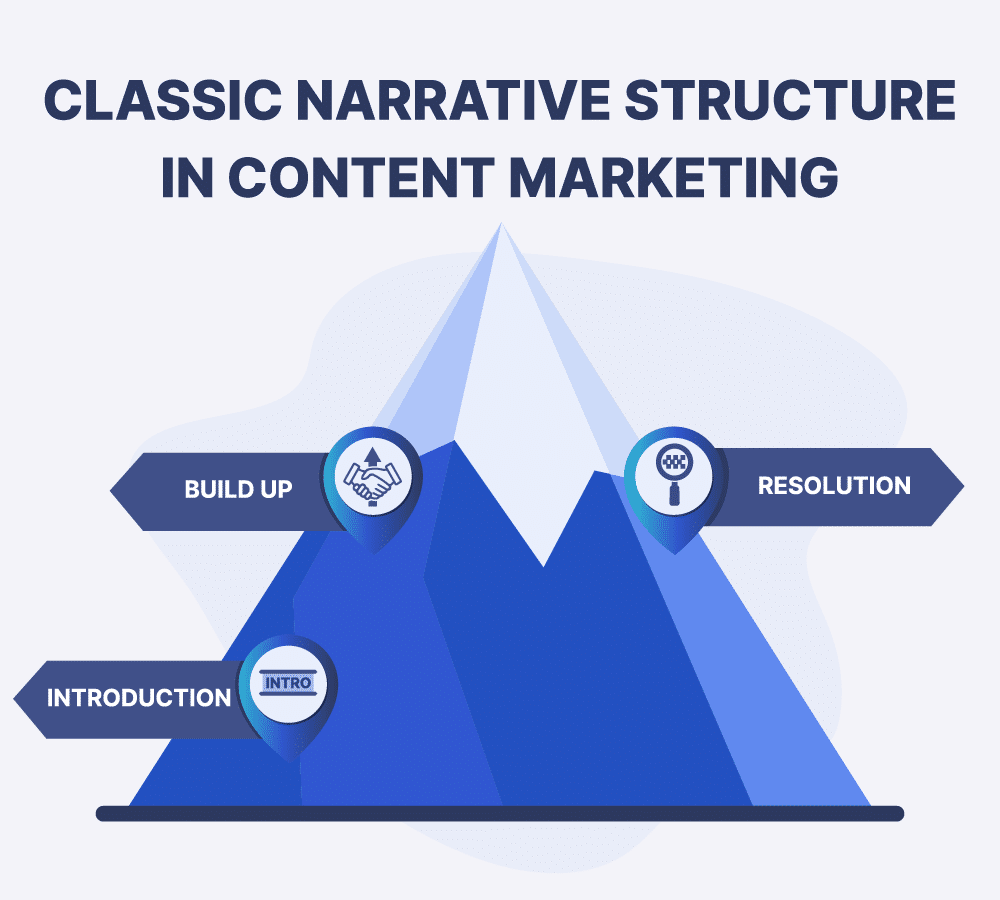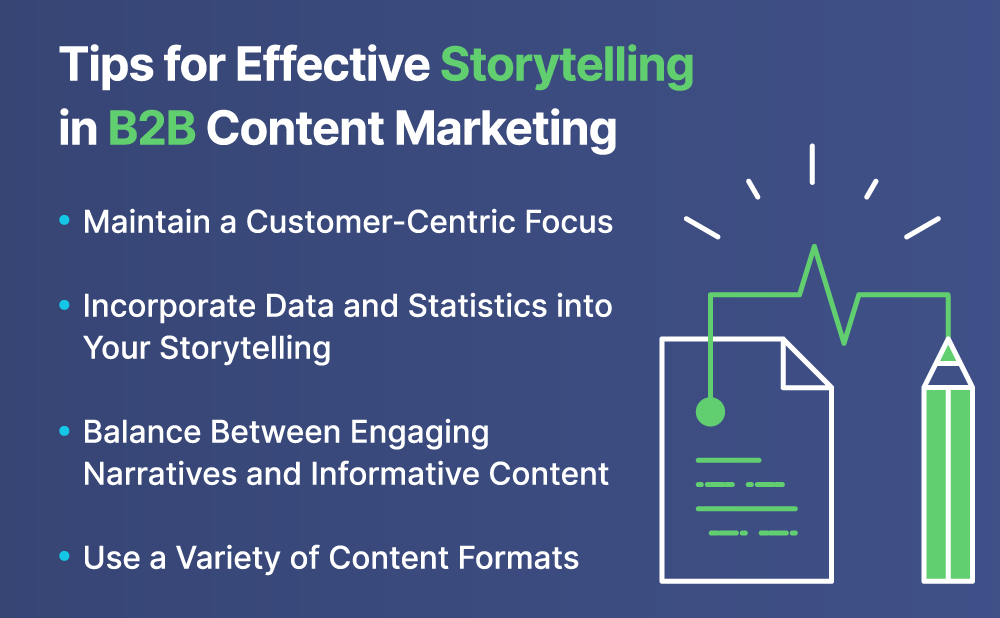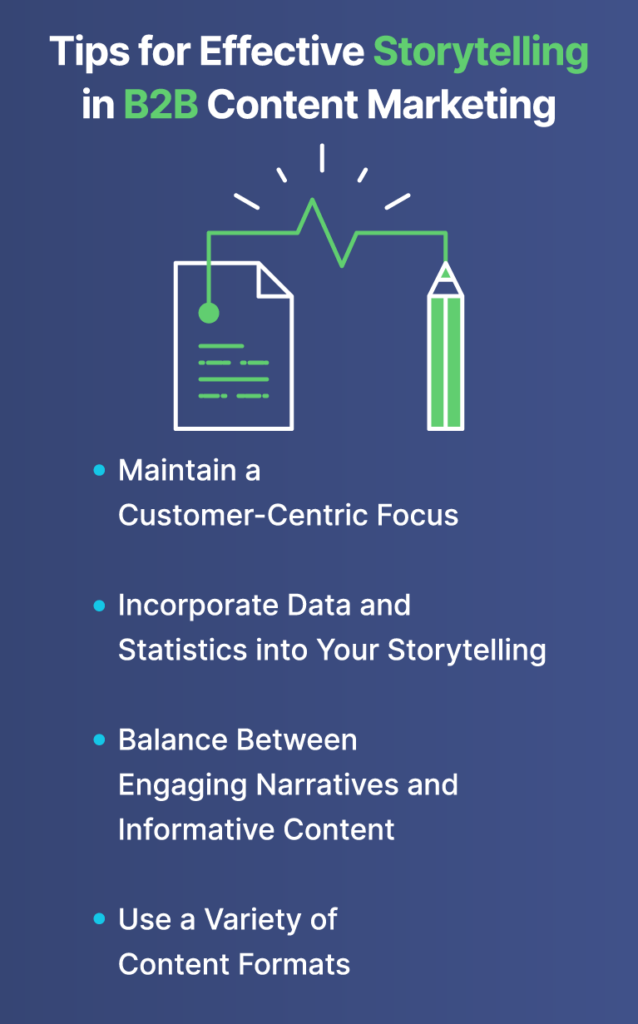It’s crucial for brands to stand out from the crowd and truly connect with their audiences. This is especially true for B2B companies that may lack the inherent excitement or buzzworthy appeal of consumer-focused brands. Enter the power of storytelling: a compelling tool that can transform even the most mundane topics into engaging and memorable content. In this comprehensive guide, we’ll explore the importance of storytelling in content marketing and offer practical tips, best practices, and successful examples to help you infuse storytelling into your content marketing strategies and campaigns. So, let’s dive in and unlock the full potential of storytelling for your brand!
Understanding the Importance of Storytelling in Content Marketing
According to Search Engine Watch, incorporating storytelling into your marketing strategy has the potential to increase conversion rates by as much as 30%. Storytelling has the power to engage and connect with audiences on a deeper level than traditional marketing messages. Through relatable narratives, brands can evoke emotions and create memorable experiences for their target market. This is especially true in B2B content marketing, where the focus on complex topics often makes it difficult to capture readers’ attention and differentiate brands from their competitors.
Incorporating storytelling into content marketing can transform seemingly mundane topics into compelling and engaging content. By presenting information through stories, brands can humanize their products or services, making them more accessible and appealing to their target audience. This approach ultimately helps to capture and retain the attention of potential customers, driving increased brand awareness and conversion rates.
Identifying Your Brand's Unique Story
Storytelling is a powerful tool in content marketing and one that B2B brands must leverage to differentiate themselves from their competitors. But, before you can start crafting compelling stories, you must first identify your brand’s unique story.
To successfully incorporate storytelling into your content marketing, it’s vital to identify your brand’s unique story. Start by assessing your brand’s values, mission, and goals. These elements will provide the foundation for your storytelling efforts and ensure that your content aligns with your company’s identity and purpose.
Finding inspiration for your brand’s story can come from various sources. Customer testimonials and case studies are excellent places to start, as they offer real-world examples of how your brand has positively impacted others. These stories not only humanize your brand but also showcase your products or services’ value, which can resonate with potential customers.
Additionally, don’t be afraid to showcase the human side of your business. Introduce your audience to the people behind your brand, sharing their stories and experiences. This approach can help create a more personal connection with your audience, demonstrating that your company is more than just a faceless entity. By identifying and sharing your brand’s unique story, you can create content that stands out and captivates your audience.
Implementing Storytelling Techniques in Content Marketing
Once you’ve identified your brand’s story, it’s time to start incorporating storytelling techniques into your content marketing. There are various approaches that can help ensure your stories effectively captivate and engage readers with their narratives.
Utilizing the Classic Narrative Structure
One such approach is utilizing the classic narrative structure, which consists of a beginning (introduction), middle (build-up), and end (resolution). This format helps establish context, build suspense, and deliver a satisfying conclusion that keeps readers engaged throughout the entire piece.

Creating Relatable Characters and Conflict
Creating relatable characters and conflict is another essential aspect of effective storytelling. By sharing stories about real people, including customers or employees, you humanize your brand and make it easier for readers to connect with your content. Additionally, incorporating conflict or challenges that your characters overcome can create a sense of intrigue and demonstrate the value your brand brings to the table.
Employing Emotion and Suspense
Employing emotion and suspense in your content marketing can also captivate readers and encourage them to engage with your brand. Emotions such as happiness, sadness, fear, and surprise can evoke strong reactions and make your content more memorable. By incorporating suspenseful elements, such as cliffhangers or unexpected twists, you’ll keep your audience eager to learn more and continue consuming your content.
Tips for Effective Storytelling in B2B Content Marketing
Effective storytelling in B2B content marketing requires careful consideration of various elements, such as audience needs, technical concepts, and content formats. To ensure your stories successfully captivate your target audience, it’s important to implement best practices and tailor your strategies for different content formats. Here are some tips to keep in mind when crafting stories for your content marketing efforts.


Maintain a Customer-Centric Focus
One crucial aspect of storytelling in B2B content marketing is to maintain a customer-centric focus. By prioritizing your target audience’s needs and pain points, you can create stories that resonate with them and showcase how your brand can provide solutions. To create content that truly resonates with them, focus on using language and phrasing that your audience can relate to.
Incorporate Data and Statistics into Your Storytelling
Incorporating data and statistics into your storytelling can help validate your narrative and build credibility with your audience. By using relevant data to support your story, you demonstrate that your content is grounded in reality and substantiated by evidence, making it more persuasive and impactful.
Balance Between Engaging Narratives and Informative Content
While storytelling is an essential component of content marketing, it is important to strike a balance between engaging narratives and informative content. Your storytelling should provide helpful information that not only entertains your audience but also helps them solve their problems. This way, your stories can drive tangible results and foster strong relationships with customers.
Use a Variety of Content Formats
Using a variety of content formats can help enhance your storytelling efforts. For example, consider incorporating visuals, such as images, graphics, or videos, to make your content more dynamic and engaging. This can help break up large blocks of text and make it easier for your audience to digest the information.
Examples of Successful Storytelling in B2B Content Marketing
One of the best ways to understand effective storytelling in B2B content marketing is by examining real-life examples from brands that have successfully implemented these techniques. By analyzing their strategies and the key elements that contributed to their success, you can gain valuable insights to apply to your own content marketing efforts.
General Electric (GE)
General Electric serves as a prime example of a brand that has mastered storytelling in B2B content marketing. They’ve created content around complex topics such as renewable energy, aerospace engineering, and healthcare technology, making these subjects engaging and accessible for their audience. GE’s “The Message” podcast combined science fiction with real-life engineering concepts to create a captivating narrative, effectively showcasing their expertise in the industry.
Maersk
Global shipping company Maersk is another example of a brand that has effectively used storytelling techniques in its content marketing. They’ve leveraged social media platforms like Instagram to share the stories of the people behind their brand – from ship captains to dock workers. By humanizing the company and providing a behind-the-scenes look at its operations, Maersk has generated interest and engagement from its audience, despite the seemingly uninteresting nature of the shipping industry.
IBM
IBM, a technology and consulting corporation, has also employed storytelling techniques successfully in its content marketing efforts. Their “Watson Analytics” campaign utilized various content formats, including blog posts, infographics, and videos, to tell the story of how their artificial intelligence technology can help businesses make better data-driven decisions. By showcasing real-life customer testimonials and case studies, IBM effectively demonstrated the value of its product through relatable, customer-centric stories.
Tailoring Storytelling Strategies for Different Content Formats
Adapting storytelling techniques for various content formats is crucial in ensuring your brand’s message remains consistent and engaging across platforms. Each format, be it blog posts, videos, or social media, has its own unique characteristics and best practices that should be considered when incorporating storytelling elements.
Blog Posts
For blog posts, focus on creating a captivating introduction to hook readers early on, and use subheadings, bullet points, and images to break up text and maintain reader interest. This format allows for more in-depth storytelling, so take the opportunity to dive deep into your narrative and provide valuable insights to your audience.
Videos
In videos, it’s essential to create a strong visual narrative that complements your story. Leverage engaging visuals, sound effects, and music to enhance the storytelling experience and evoke emotions in your viewers. Keep in mind that videos often have a shorter runtime, so ensure your story is concise and impactful.
Social Media Platforms
Social media platforms, with their limited character count and fast-paced nature, require a more succinct storytelling approach. Focus on crafting a compelling headline or caption to grab the audience’s attention, and use visuals like images, GIFs, or short videos to further convey your story. Remember to adapt your storytelling style to each platform’s unique audience and tone, such as using more casual language on Twitter and a more professional tone on LinkedIn.
Long-Form Content and Short-Form Content
Knowing when to use long-form vs. short-form storytelling is also important in content marketing. Long-form content, like eBooks or whitepapers, allows for more comprehensive storytelling and is suitable for addressing complex topics. Short-form content, on the other hand, is ideal for quickly capturing the audience’s attention and conveying bite-sized pieces of information.
Ensuring consistency in messaging across platforms is vital to maintaining your brand’s identity and building trust with your audience. Develop a cohesive brand voice and storytelling style that can be adapted to different formats while remaining true to your brand’s values and personality.
Measuring the Success of Storytelling in Content Marketing
Measuring the success of your storytelling strategies is essential in understanding how your content is resonating with your target audience and driving tangible results. While it can be difficult to quantify the impact of storytelling, there are various metrics and tools that can help assess the success of your content marketing efforts.
Identify Relevant Key Performance Indicators (KPIs)
To effectively measure the success of storytelling in content marketing, it is essential to identify relevant key performance indicators (KPIs) that align with your brand’s goals and objectives. KPIs may include metrics such as website traffic, social media engagement, lead generation, conversions, and customer retention. By closely monitoring these KPIs, you can evaluate the impact of your storytelling efforts and determine whether they are resonating with your target audience.
Analyzing Engagement Metrics
Analyzing engagement metrics is another crucial aspect of assessing the effectiveness of storytelling in content marketing. Metrics such as time spent on a page, bounce rate, social shares, and comments can provide valuable insights into how your audience is interacting with your content. High engagement levels often indicate that your storytelling techniques are successfully captivating your readers and encouraging them to engage with your brand.
Overcoming Challenges in B2B Storytelling
Storytelling in B2B content marketing can present various challenges, such as navigating complex topics and industry jargon, addressing skepticism from target audiences, and standing out among competitors. Leveraging best practices and utilizing the right resources and tools can help you overcome these hurdles and create compelling content that resonates with your target audience.
Skepticism From Target Audiences
Addressing potential skepticism from target audiences is a common challenge in B2B storytelling. To overcome this, ensure that your stories are authentic, credible, and supported by data or testimonials. Demonstrating real-world results and showcasing the impact of your product or service on customers can help establish trust and credibility with your audience.
Complex Subject Matter and Industry Jargon
Navigating complex subject matter and industry jargon presents another hurdle in B2B storytelling. To tackle this issue, simplify technical concepts and use clear, concise language that is accessible to a broader audience. Focus on the benefits your product or service provides, rather than delving into overly technical details. This will make your story more relatable and easier to comprehend for readers who may not be experts in your industry.
Standing Out Among Competitors
Standing out among competitors with similar stories can be difficult, especially in industries with limited differentiation. To differentiate your brand, find unique angles and perspectives to share, highlighting aspects of your company’s culture, values, or history that set it apart. Dig deep into your customer experiences and testimonials to uncover stories that showcase how your brand has made a tangible difference in their lives or businesses. Another approach to standing out is by experimenting with different storytelling formats and mediums, such as video, podcasts, or interactive content. This can help capture the attention of your target audience and provide a fresh perspective on your brand’s story.
Resources and Tools to Enhance Your Storytelling Skills
To further develop your storytelling skills and create more engaging content for your brand, it’s essential to invest in continuous learning and leverage the right tools. Here are some recommended resources and tools to help you on your storytelling journey:
- Books and Articles: There are numerous books and articles available that can help you refine your storytelling techniques. Some popular titles include “The Storytelling Edge” by Joe Lazauskas and Shane Snow, “Building a StoryBrand” by Donald Miller, and “Stories That Stick” by Kindra Hall. These books offer valuable insights and practical tips for improving your storytelling skills in content marketing.
- Online Courses: Taking online courses can be a great way to learn from experts in the field and expand your knowledge of storytelling. Platforms like Coursera, LinkedIn Learning, and Udemy offer courses on storytelling, content marketing, and related topics. Look for courses that are tailored to B2B content marketing and focus on storytelling best practices.
- Tools for Creating Visually Appealing Content: Crafting visually engaging content is an important aspect of storytelling. Tools like Canva, Adobe Creative Cloud, and Visme can help you design captivating graphics, images, and videos to complement your written content. These tools offer an array of templates and features that make it easy for users to create professional-looking visuals, even without design experience.
- Platforms for Sharing and Promoting Your Brand’s Story: Once you’ve crafted your story, it’s important to share it with your target audience effectively. Content distribution platforms like Medium, LinkedIn, and industry-specific forums can help you reach a wider audience. Additionally, social media management tools like Buffer and Hootsuite can assist in scheduling and promoting your content across different platforms, ensuring consistency in messaging and maximizing your content’s reach.
Conclusion
As we’ve explored in this guide, storytelling is a powerful tool in content marketing, especially for brands that may lack inherent excitement. By identifying your brand’s unique story, implementing effective storytelling techniques, and adapting your strategies for different content formats, you can create compelling and engaging content that resonates with your target audience.
If you’re ready to take your content marketing efforts to the next level, consider using a content tool like ConvertIQ. With expertise in content strategy, content marketing, and integrated content experiences, we can help you craft captivating stories that connect with your audience and drive results. Let’s work together to elevate your brand storytelling and make your content stand out among the competition. Reach out to us today to get started on creating exceptional content for your business.
